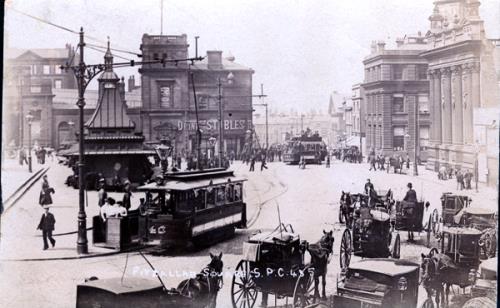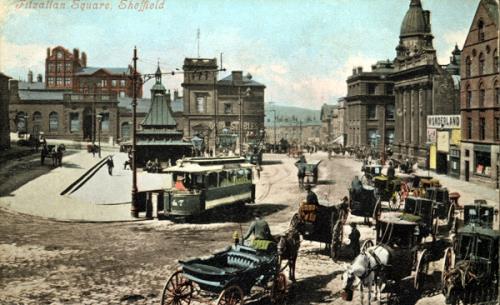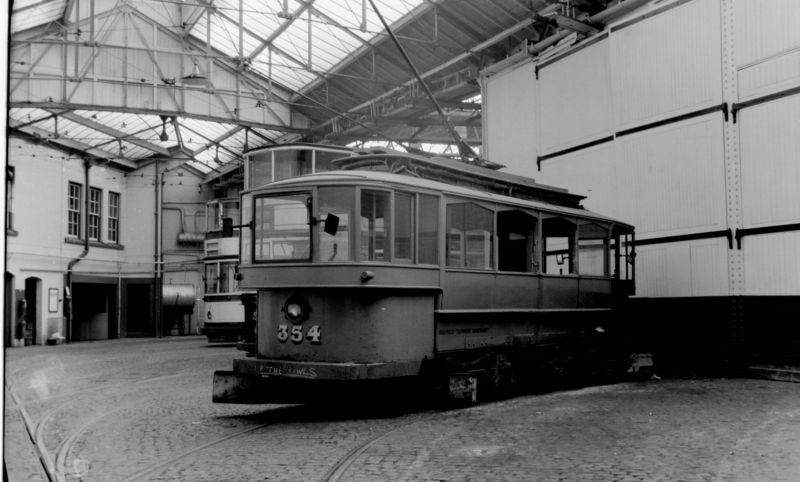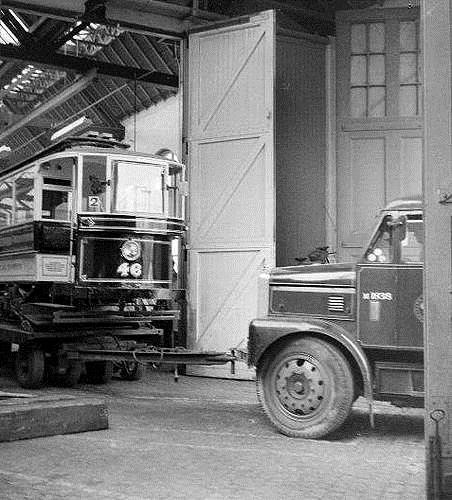Another Sheffield tramcar in our collection with an anniversary to celebrate this year is Sheffield 46, which is 125 years old in September 2024. This small single deck electric tramcar had a seating capacity not much larger than the horse trams it helped to displace, with a 28-person capacity as opposed to 16. The tramcar was very much a compromise when it entered service in the autumn of 1899.

Image 1: An early single-deck tramcar in Fitzalan Square, Sheffield, in the early 1900s (National Tramway Museum collection).

Image 2: Sister car Sheffield 47 at the end of the first short siding in Fitzalan Square in the early 1900s (National Tramway Museum collection).
Sheffield, as a major manufacturing city, was keen to introduce higher capacity tramcars, preferably double deck, to convey its many residents to work and back. However, the city’s steep hills and tight curves posed a major challenge when the horse tramways were extended out into much hillier districts such as Walkley, Intake, Crookes and Pitsmoor.
By acquiring twelve small single deck tramcars equipped with enhanced braking mechanisms to service the Walkley route, the tramway authorities hoped to convince inspectors from the Board of Trade that it would be safe to operate. On 18th September 1899, the extension to Walkley was finally opened after the inspector advised a three-week delay to allow for additional training of drivers. He also imposed a number of speed restrictions and compulsory stops on certain sections of the route.
Other hilly routes were also authorised on the same basis in subsequent years. Gradually, the design and performance of double deck tramcars was improved by the adoption of more powerful motors and a new system of power brakes, which helped to persuade Board of Trade inspectors to allow such cars to replace the smaller single deckers. Eventually, in November 1914, permission was granted to convert even the steepest Walkley and Intake routes to double deck tramcar operation.
Single deck tramcars such as Sheffield 46 were still required to service a couple of tram routes that were impassible to double deck cars because of low railway bridges. Once these were all reconstructed by 1920, there was no longer any need for such small tramcars in the fleet. Sheffield 46 was withdrawn from passenger service at this point and converted into a snowplough, Sheffield being one of only a handful of tramways to maintain a specific fleet of emergency vehicles for clearing snow and ice.
The conversion process involved the removal of the central window section and the installation of a chute at the bottom of the rocker panel, which enabled the car to spread its load of salt onto the tracks. The tramcar was also renumbered several times as new tramcars were added to the fleet and given the numbers of older ones that had been withdrawn. No. 46 eventually ended up as No. 354 in 1937.
In August 1940, the vehicle was equipped with distinctive looking protruding vestibules. In 1950 it was the only works tramcar to be equipped with “a special chain-driven salt spreader”, which spread salt across the whole track.

Image 3: Sheffield works car No. 354 in Queens Road Depot, Sheffield, 7 November 1954. Photo by M J O’Connor.
In early 1960, just months before the closure of the tramway, Sheffield 46 was purchased by the (then infant) Tramway Museum Society. While in temporary storage at Tenter Street Depot, members of the society were given permission to begin the task of restoring the grey works car to its original status as a passenger tram. This involved the removal of salt-spreading equipment and also the stubborn residue of several decades of salt encrustation. Seats and other fittings were obtained from another of the single deck tramcars (133) and Sheffield Transport Department was persuaded to repaint it in its original Prussian blue and cream livery. Its original number was reinstated, along with replacement lifeguards and window glazing. In this guise, Sheffield 46 was allowed to run in the final tramcar procession in Sheffield on 8th October 1960. Tickets were restricted for purchase by members of the Tramway Museum Society.

Image 4: Sheffield 46 leaving Queens Road Depot, Sheffield, bound for Crich in October 1960. Photograph by M J O’Connor.
After the procession, the tramcar was transported to Crich on 28th October 1960. A further restoration process was then undertaken, which took seven years to complete, at the end of which the tramcar was given a celebratory repaint. To mark the occasion, the Lord Mayor and Lady Mayoress of Sheffield were invited to ride on the tramcar for its inaugural run on 19th August 1967.
The tramcar had already entered service at Crich in 1964 and, apart from 1979, continued to operate until its withdrawal in 1973. It was given a repaint in 1988 in time for that year’s Yorkshire Event, which took place on 26th June.

Image 5: Sheffield 46 during a Victorian Day photographic shoot on 14th August 1971 (National Tramway Museum collection).
By this time, the condition of the tramcar was deteriorating on account of its long usage as a snowplough and the resulting salt corrosion. In January 2006, it was removed to the Museum’s off-site storage facility. It remains there while consideration is given to a possible future restoration. Given its various guises and modifications over the years, deciding how best to restore Sheffield 46 is not a straightforward process.

Image 6: Sheffield 46 on the depot fan at Crich, 24th September 2005 (Enthusiasts’ Day), shortly before it was taken into long-term storage. Photograph by Jim Dignan.
With thanks to Museum Volunteer Jim Dignan for producing this article.
Image References:
1. National Tramway Museum collection
2. National Tramway Museum collection
3. Maurice O’Connor
4. Maurice O’Connor
5. National Tramway Museum collection
6. Jim Dignan
